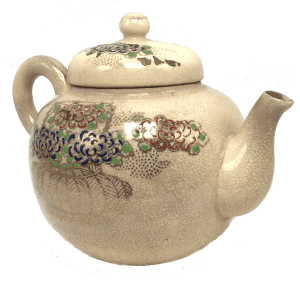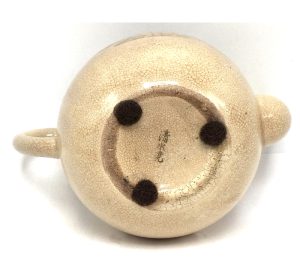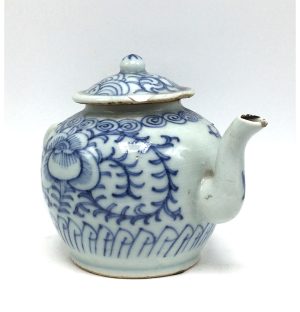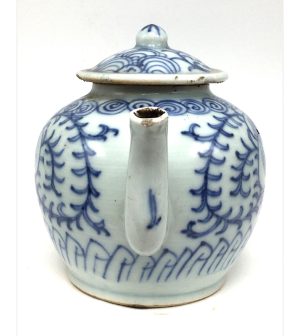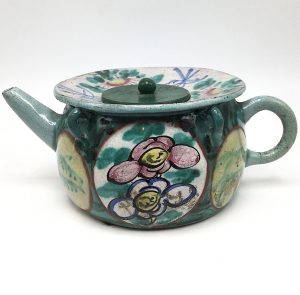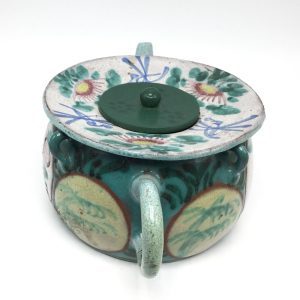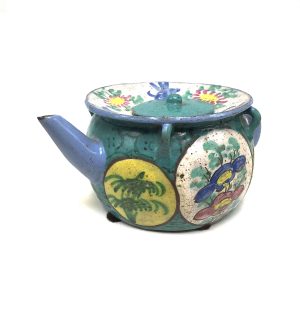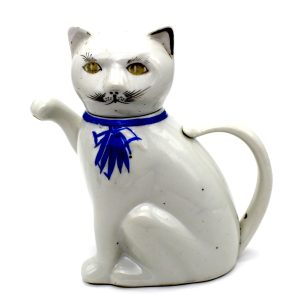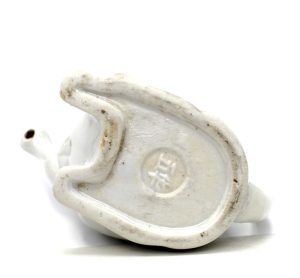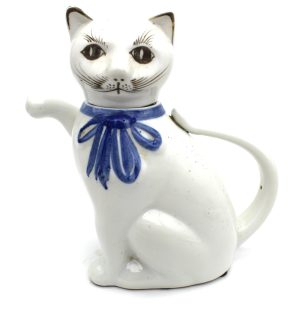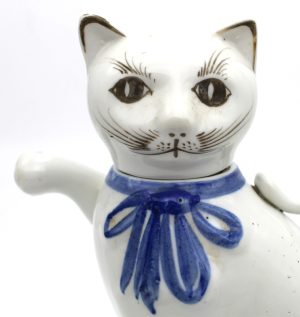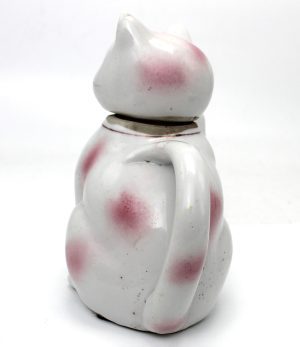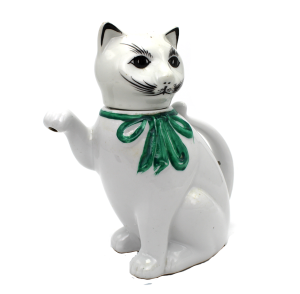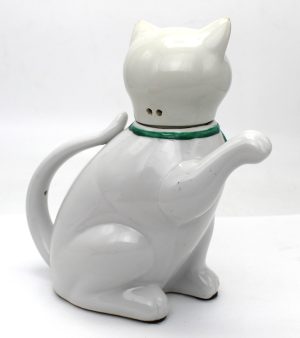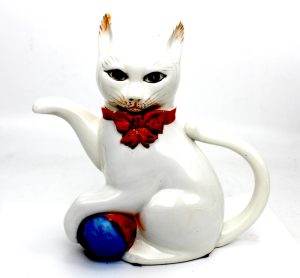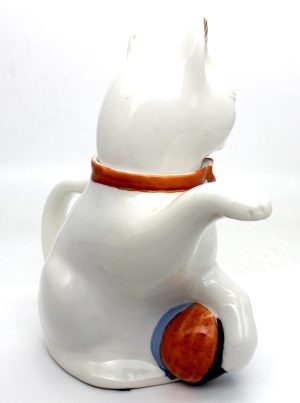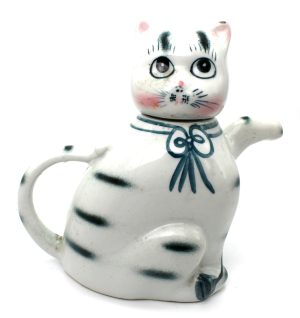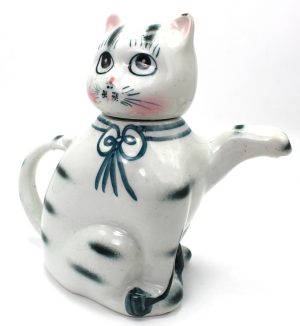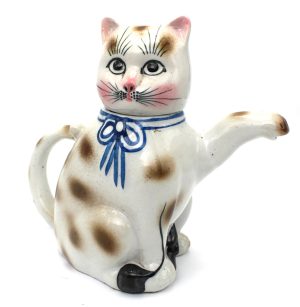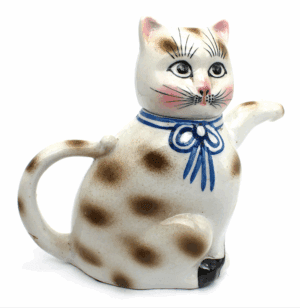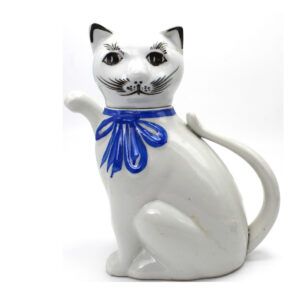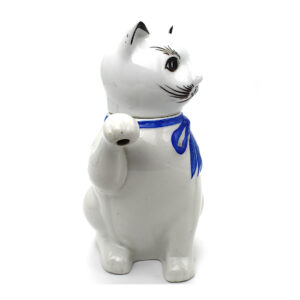Showing 1–12 of 14 results
-
Sale!


$285.00 Original price was: $285.00.$225.00Current price is: $225.00.
H: 4” W: 5.25” D: 3.5” | FREE SHIPPING WITHIN CONTINENTAL U.S.
Hand thrown and -painted Meiji single serving Kyo Ware teapot with luminescent crackled glaze and kiln seal. A chrysanthemum in a basket symbolizes longevity and rejuvenation. Kyo ware is limited, making it collected worldwide.
-
Sale!


$175.00 Original price was: $175.00.$115.00Current price is: $115.00.
H: 5.25” W: 4.75” D: 2.375” | FREE SHIPPING IN CONTINENTAL US
Small teapot with intricate cobalt blue chrysanthemum and bindweed designs widely used in late 19th century in domestic and export wares. Ball handle on lid.
-
Sale!


$365.00 Original price was: $365.00.$295.00Current price is: $295.00.
H: 2.625” W: 6.125” D: 4” | FREE SHIPPING WITHIN CONTINENTAL U.S.
Small antique Yixing teapot with small loops below rim indicating may have been used to suspend oil or soy sauce. Hand painted vibrant enamels with circular panels of floral and leaf decorations.
-
Sale!


$365.00 Original price was: $365.00.$295.00Current price is: $295.00.
H: 2.6 ” W: 6.1 ” D: 4 ” | FREE SHIPPING WITHIN CONTINENTAL U.S.
Brightly hand- painted enamel with fanciful floral and leaf decorations, this small teapot a has circular loop handle, short spout, flaring rim and small flat cover. Although Yixing ware considered the best for brewing tea, antique pieces are for decorative and collecting purposes only.
-
Sale!


$145.00 Original price was: $145.00.$125.00Current price is: $125.00.
Ht: 6.25” W: 5.5” D: 3.25” | FREE SHIPPING WITHIN CONTINENTAL U.S.
The Chinese characters within a circled seal in the mold on the bottom indicate this teapot is an antique. As the thin ribbon blue collar as wishes for long life, it is a perfect birthday gift. Recommended for decorative use only.
-
Sale!


$145.00 Original price was: $145.00.$125.00Current price is: $125.00.
H: 7” W: 7” D: 3.5” | FREE SHIPPING IN CONTINENTAL US
Porcelain cat teapot removable head, sinuous tail handle. Beautifully hand-painted whimsical ribbon-like blue collar, dangling ornamental bow, and the black accents. Likely Qing Dynasty circa 1900-1920.
-
Sale!


$135.00 Original price was: $135.00.$115.00Current price is: $115.00.
H: 5.5″ W: 3″ D: 3.375″ | FREE SHIPPING WITHIN CONTINENTAL U.S.
Antique porcelain teapot, removable head, tail handle, and spout paw. Hand painted design with ribbon-like gold collar and dangling ornamental bow symbolizing long life. Great gift, recommended for decorative use only.
-
Sale!


$145.00 Original price was: $145.00.$125.00Current price is: $125.00.
H: 6.5″ W: 6.5″ D: 3.5″ | FREE SHIPPING WITHIN CONTINENTAL U.S.
Porcelain teapot with removable head and long sinuous tail handle ,Whimsical design with green ribbon collar and dangling ornamental bow. Bottom stamp and seal date to Qing Dynasty/Chinese Republic ca 1900-1920.
-
Sale!


$145.00 Original price was: $145.00.$125.00Current price is: $125.00.
H: 8” W: 8” D: 3.75” | FREE SHIPPING IN CONTINENTAL US.
Beautifully hand-painted whimsical cat tea pot with red collar ribbon, ornamental bow, and ball under left paw. Black, orange, red and blue accents on face, ears, head, paws and ball. Bottom double stamped seal.
-
Sale!


$145.00 Original price was: $145.00.$125.00Current price is: $125.00.
H: 7” W: 8” D: 3.625” | FREE SHIPPING WITHIN CONTINENTAL U.S.
Rotund porcelain teapot with removable head. With her pink highlights, round wide eyes, feathered brows and 3 part ribbon with bow she appears to be an affectionate female lap cat.
-
Sale!


$145.00 Original price was: $145.00.$125.00Current price is: $125.00.
H: 7” W: 8” D: 3.625” | FREE SHIPPING WITHIN CONTINENTAL U.S.
Unique rotund teapot of cat protectively sitting on a mouse. Raised paw spout, removable head and sinuous tail handle. Blue collar ribbon with bow symbolize long life. Black, pink, brown accents on face, ears, head, paws and body.
-
Sale!


$130.00 Original price was: $130.00.$115.00Current price is: $115.00.
H: 8” W: 8” D: 3.75” | FREE SHIPPING WITHIN CONTINENTAL U.S.
This charming vintage porcelain cat teapot with raised paw for pouring tea, removable head and a sinuous tail handle is whimsical and colorful with a red ribbon collar, green bow and green, black and red accents defining the expressive face, ears, head and paws, all beautifully hand-painted. Manufactures seal on bottom.
End of content
End of content

